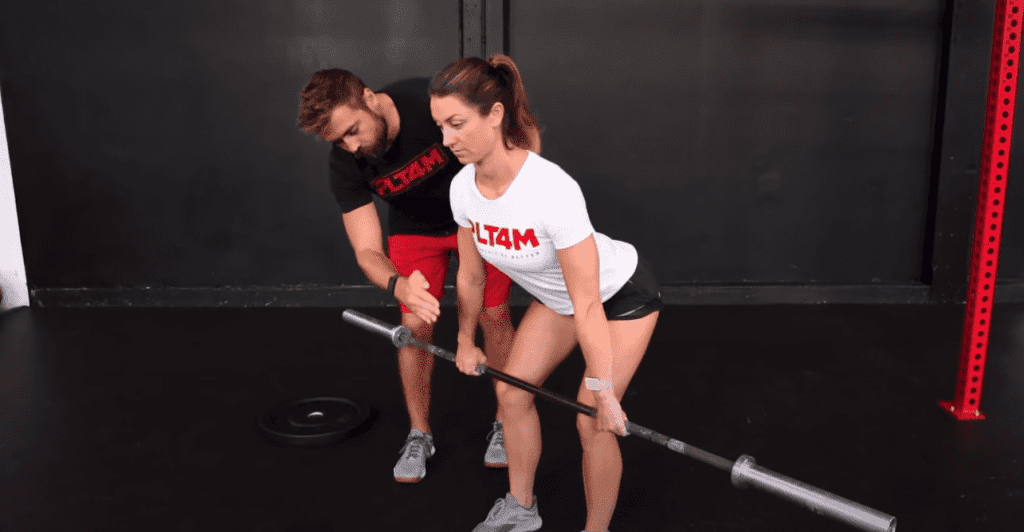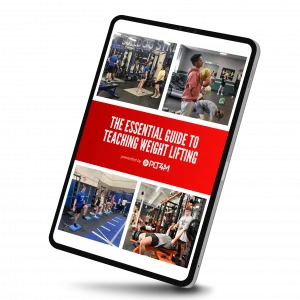The hang clean is a popular movement in strength and conditioning programs. Mastering proper hang clean form is crucial for performance and safety. In this article, we will start by breaking down key terminology of the power clean and its variations. Next, we will highlight proper hang clean form through instructional videos and notes. Lastly, we will talk about some of the common mistakes when performing the hang clean and break down tips and tricks to maximize the exercise.
The Clean – Key Terms For This Olympic Weightlifting Movement
The clean (as part of the clean and jerk) is one of only 2 olympic lifts – the other being the Snatch (just like the squat, bench press, and deadlift are considered “Power Lifts”). As defined by the International Weightlifting Federation‘s (IWF) rules for competition, a clean is performed anytime a barbell is “pulled in a single movement from the platform to the shoulders, while either splitting or bending the legs.” Simply put, a clean is a lift that moves a barbell from the floor to a front rack position at the shoulders.
So, first we must establish a concrete understanding of the starting position on any clean rep. Here are the three most basic:
Clean = From the floor (like a deadlift)
Hang Clean = From an established hang anywhere above the knees (like a kettlebell swing)
High Hang Clean = From the pockets, or jumping position
Once we understand the starting point of the bar, we must nail down where the bar will end up, also known as the receiving position, or catch. Firstly, we must understand that any clean rep ends with the bar in our front rack in the standing position, just like our Front Squat!
We are talking about the hip level desired when the bar lands in our front rack. The lower the hips, the less distance the bar has to travel to reach the catch and vice versa. Thus, different catches should determine different loading and come from different training intents. Being such, it behooves us to be clear with our prescription.
Free E-Book: Essentials to Teaching Weight Training
Discover proven strategies for building and improving your school’s weight training program
Partial Squat or Full Front Squat?
It must be acknowledged that there is some discrepancy amongst coaches, teachers, and trainers as to what catch constitutes a standard clean rep, regardless of starting position. Let’s be sure to clear this up when talking about hang clean form.
Many coaches claim that a full clean requires a full squat. Some coaches simply abide by the IWF definition and believe that depth of the catch does not matter (even a split catch, like on a split jerk, is accepted in competition but is rarely used).
Others have popularized specifying the full movement in detail to be completely clear on any rep. A squat clean requires a catch with hips below parallel, while a power clean requires hips above.
If the clean is labeled by neither, the athlete is allowed to perform the movement with either catch (often determined by the load).
Hang Clean Form Starts With A Hinge
The hang clean is an explosive movement and one that can be intimidating for new individuals to learn and perform. But proper hang clean form starting by building a strong foundation.
First, we should be certain that individuals know the proper form of the hinge movement pattern. Before introducing a barbell, this can be done through different variations of a good morning and medball/dumbbell deadlift.
Next, many coaches and teachers like to introduce the barbell deadlift. By developing proper form of the deadlift, individuals can begin to safely take the barbell from the ground and perform different variations of the clean. (All of these parts can be done through fitness lesson plans and weight training lesson plans.)
From here, individuals are set up for success to execute excellent hang clean form. Let’s take a closer look at the high hang clean and hang clean.
Ready to Learn More?
Schedule a free 10 minute consultation to see how PLT4M powers high school weight rooms across the country.
High Hang Clean Form
Trying the clean for the first time can be a tricky endeavor due to its many moving parts. Here at PLT4M, when it comes to teaching good hang clean form we like to start at the “top” with the most basic element of the clean and work our way down over time. Thus, we begin by teaching the “High Hang Power Clean” – basically focusing on the jump and pull with a catch in our front rack position. Beyond being a great place to start learning the Olympic weightlifting movement and hang clean form, it is an excellent tool for developing rate of force production as well as a great reinforcement of technique for the lift at large.
Hands & Feet:
The individual’s feet should be in a neutral position directly under the hips. Their hands should be at least “thumb-swiping” distance from the thighs on the bar, with the arms hanging long and loose from the shoulders.
Position 1/Jumping Position:
From here, we instruct the individual to simply “soften” the knees, or bend them slightly. The torso remains vertical, we’re not looking to lean forward, here. It is just a little 2 inch dip of the hips.
Pull & Catch Position:
We tell the individual to jump with the legs while pulling the bar up the torso. Cue them to try and pull their shirt up with the bar, keeping the elbows high and outside. Once the bar has reached chest height, we shoot the elbows through and assume a quarter squat position – also known as the power position.
Hang Clean Form
We are initiating the movement from Position 2 – or the traditional “Hang” position. While being the most commonly performed variation of the lift, here is where most struggle to execute hang clean form successfully.
It is during this phase of the full clean lift that we begin to increase the speed of our bar with the pull from position 2 (the traditional hang position – just above the knee) to position 1 (the high hang or pockets). Arms stay long and knees stay “soft” as we pull the torso through to a vertical position using our posterior chain – primarily our hamstrings.
This means, during our hang power clean reps, we must establish our set-up position well with a hinge out over the bar, loading up the posterior chain, AND we must be patient with our jump. We must create movement first with our reverse hinge at the hip, pulling the bar up the thighs to our vertical torso jumping position (Position 1!).
No early jumping or pulling with the arms.
At position 1 we are now jumping aggressively, opening the hips to full extension, which drives the bar upward. We carry this momentum with our upward pull of the bar.
Once the bar has reached the top of our torso, we are sending our butts back and ripping the elbows forward, catching the bar in our front rack position.
Being a “power” clean rep, we must catch the bar with our hips ABOVE parallel. Most specifically, we are looking for a solid 1/4 squat position on each rep.
We then stand to full hip extension before either dropping the bar from the top and resetting for the next rep, or recovering the bar back down to Position 1, then Position 2, for a subsequent rep.
Common Mistakes and Tips & Tricks To Fix Them
While we just broke down good form and technique, introducing different variations of the clean exercise will often result in individuals struggling to hit the movement correctly.
Much like the deadlift, individuals can get away with doing the movement with heavier weights, even when form suffers. In this case, we need to always be mindful of proper hang clean form and movement mechanics to promote safety and longevity of this olympic weightlifting exercise.
High or Low Elbows
When performing the clean exercise, your front rack position is vital to the movement.
Many times, when working with new athletes or students, we see a tendency to catch the bar with a full grip and elbows down. This is something that should addressed ASAP when it comes to hang clean form. You will only be able to move heavier weights effectively (and safely!) if the weight is kept in an advantageous position via a proper “Front Rack”.
This means that the barbell must remain over your heel-arch (the midline of your body) with a vertical torso beneath it. If the elbows drop, the chest collapses and the weight comes forward at all, you lose your stability and power and will fail the lift. To keep the barbell in place, the elbows must be high. We are looking to keep the upper arm as close to parallel of the floor as possible.
Remind your athletes, when we catch ANY clean rep, we want HIGH ELBOWS!
Power vs Starfish
Another very common fault we see with developmental students or athletes with hang clean form exists from the hips down. We’re talking hip and foot positioning under our front rack catch.
Often, individuals will jump the feet out wide in an effort to stabilize the weight. While this is instinctual for many, it puts them in an unsafe position under load, and also limits their ability to move weight. Cue them to avoid this starfish catch, and jump from hip-width to shoulder width.
We want ANY clean rep to be caught in such a position that could feed directly into a full-depth squat.
There are a number of ways to fix this issue. You can use a tactile cue by placing your foot or other obstacle in the way of excessive width, or a visual cue with a taped target area on the floor. However you approach it, the key is to reinforce a good power position, allowing for depth at greater loads.
Arms Don’t Bend
When it comes to the Clean, or Olympic Lifting in general, many young individuals fail to truly grasp that the power comes from the hips.
It is NOT the arms that do a lions share of the work. Simply because of the way the barbell is held, many have a tendency to try and “Pull” the bar with the biceps rather than allowing the larger muscles of the posterior chain to do the work.
The key to successful power transfer (and thus, successful reps at heavier weights) is the inverse relationship between the hips and arms. What we mean is essentially: “The arms don’t bend until the hips “extend”. Many individuals are tempted to use mostly upper body and “pull” the bar with their arms before recruiting the maximum power of their legs with a vertical jump. This is why we want to reinforce the habit of getting all the way back to this long-armed position 1 before jumping or pulling with the arms.
Jump, don’t pull when it comes to mastering hang clean form.
Key Takeaways on Hang Clean Form
Many teachers, coaches, and trainers are skeptical of the hang clean exercise. Is the juice worth the squeeze? Can you substitute this complex movement out for a different variation that still promotes explosive strength, power, and force development?
Long story short, different variations of the clean exercise are an excellent addition to a strength and conditioning program when form and technique are top of mind. Great hang clean form starts by building a strong foundation of the hinge and then focusing on the subsequent parts of the movement.
For example, at Evergreen High School in Ohio every student is introduced to the hang clean during a fitness and strength program. Teacher and coach Aaron Schmidt was amazed to see great hang clean form in only the first few sessions of introducing the movement,
“This has usually been a tough movement to teach the kids to do correctly. But because the coaching cues from the good morning, medball clean, to hang clean had been so consistent throughout the lessons and curriculum, students picked up the new movement with relative ease.”








